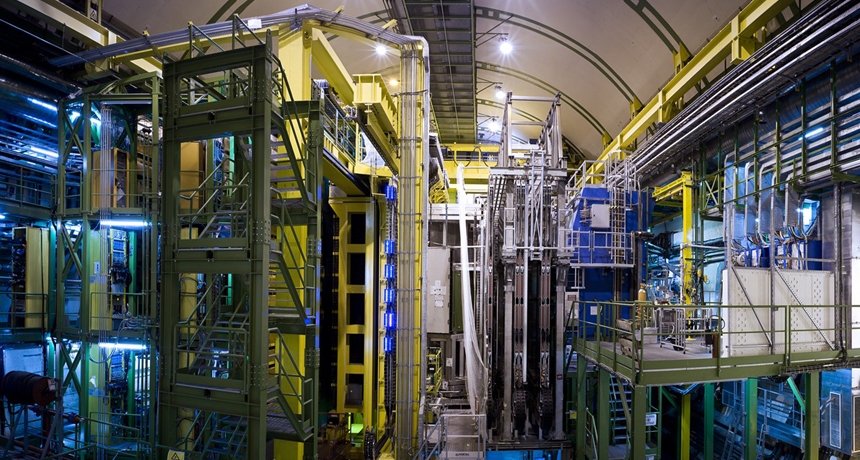New particle may help probe strongest force in the universe
Its detection allows probe of what holds the nucleus of an atom together

Scientists used the Large Hadron Collider in Europe, shown here, to find evidence of a new particle. The find could shed light on the glue that binds together the nucleus of every atom.
MAXIMILIEN BRICE/© 2009 CERN
By Andrew Grant
A new addition to the family of subatomic particles may shed light on the universe’s strongest force. It’s the force that holds together the nucleus of every atom.
The newly observed particle has an unwieldy name: D*s3 (2860)ˉ. Like the protons and neutrons that make up an atom’s nucleus, D*s3 (2860)ˉ is made up of fundamental units of matter called quarks.
Scientists discovered the new particle using an instrument at the Large Hadron Collider, or LHC. (A hadron is any particle made of quarks.) LHC is the world’s most powerful particle accelerator. This device, also known as a synchrotron, is located outside Geneva, Switzerland. A collider accelerates particles up to close to the speed of light, then smashes them together.
The two kinds of quarks that make up the new particle are heavier than those in most other particles. That makes D*s3 (2860)ˉ about three times as hefty as a proton. Its large mass also makes the particle an ideal target for studying the strong force that binds quarks to each other.
Despite its incredible strength, the strong force (also called the strong interaction) is difficult to study. That is because it acts only over very short distances.
The discovery is detailed in the October 17 issue of Physical Review Letters and the October 1 Physical Review D.
Power Words
accelerator (in physics) Also known as a particle accelerator, this massive machine revs up the motion of subatomic particles to great speed, and then beams them at targets. Sometimes the beams are used to deliver radiation at a tissue for cancer treatment. Other times, scientists crash the particles into solid targets in hopes of breaking the particles into their building blocks.
atom The basic unit of a chemical element. Atoms are made up of a dense nucleus that contains positively charged protons and neutrally charged neutrons. The nucleus is orbited by a cloud of negatively charged electrons.
force Some outside influence that can change the motion of a body, hold bodies close to one another, or produce motion or stress in a stationary body.
hadron One of a group of particles that are made up of other, smaller particles — quarks — held together by a particular kind of force. The protons and neutrons found in the nucleus of atoms are hadrons.
mass A number that shows how much an object resists speeding up and slowing down — basically a measure of how much matter that object is made from. On Earth it’s often referred to as something’s weight.
nucleus Plural is nuclei. (in physics) The central core of an atom, containing most of its mass.
proton A subatomic particle that is one of the basic building blocks of the atoms that make up matter. Protons belong to the family of particles known as hadrons.
quarks A family of subatomic particles that each carries a fractional electric charge. Quarks are building blocks of particles called hadrons. Quarks come in types, or “flavors,” known as: up, down, strange, charm, top and bottom.
standard model (in physics) It’s an explanation of how the basic building blocks of matter interact, governed by the four fundamental forces: the weak force, the electromagnetic force, the strong interaction and gravity.
subatomic Anything smaller than an atom, which is the smallest bit of matter that has all the properties of whatever chemical element it is (like hydrogen, iron or calcium).
synchrotron A circular particle accelerator that speeds up charged particles to nearly the speed of light, by applying magnetic and electric fields that ramp up their strength in synchrony. It also relies on a combination of different types of magnets to keep the beam of particles circulating and focused.







